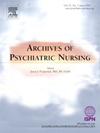Evaluating the impact of the Minimization of Aggression and Violence (MoAV) intervention on mechanical restraint use in Qatar's acute mental health setting
IF 2.2
4区 医学
Q1 NURSING
引用次数: 0
Abstract
Background
In inpatient psychiatric units, around 50 % of patients exhibit aggressive symptoms, with aggression and violence being common issues. While mechanical restraint is least preferred by patients and is considered a last resort by healthcare professionals, its use might be preventable. Minimization of Aggression and Violence (MoAV) intervention in acute mental health services offers a comprehensive assessment, comprehensive staff training in de-escalation, and the implementation of evidence-based, proactive, and non-invasive measures can help reduce the need for restraints.
Aim
To assess the impact of the MoAV intervention introduced in 2017 across acute inpatient mental health services, focusing on its effect on physical restraint incidents. A retrospective analysis compared data from 2016 (pre-intervention) and 2021 (post-intervention).
Result
There was a significant reduction in the number of restraints from 253 in 2016 to 47 in 2021. The percentage of restrained patients decreased from 25 % to 4 %, p = (<0.001). The mean duration of restraint incidents slightly increased from 59.1 min in 2016 to 61.3 min in 2021, though this change was not statistically significant.
Conclusion
Overall, the MoAV intervention appears to have made significant strides in reducing restraint use in acute mental health settings. Further research and continuous evaluation are essential to build on these findings and enhance patient care and safety.
评估在卡塔尔急性心理健康环境中,尽量减少侵略和暴力(MoAV)干预对机械约束使用的影响
在精神科住院病人中,大约50%的病人表现出攻击性症状,攻击和暴力是常见的问题。虽然机械约束是患者最不喜欢的,被医疗保健专业人员认为是最后的手段,但它的使用可能是可以预防的。在急性精神卫生服务中,减少攻击和暴力(MoAV)干预提供了全面的评估,全面的工作人员降级培训,以及实施循证、主动和非侵入性措施,可以帮助减少对限制的需求。目的评估2017年在急性住院精神卫生服务中引入的MoAV干预措施的影响,重点关注其对身体约束事件的影响。回顾性分析比较了2016年(干预前)和2021年(干预后)的数据。结果2016年至2021年,住院人数由253例减少至47例。受约束患者的百分比从25%下降到4%,p = (<0.001)。约束事件的平均持续时间从2016年的59.1分钟略微增加到2021年的61.3分钟,尽管这一变化没有统计学意义。结论:总体而言,MoAV干预似乎在减少急性精神卫生机构的约束使用方面取得了重大进展。进一步的研究和持续的评估对于在这些发现的基础上加强病人护理和安全至关重要。
本文章由计算机程序翻译,如有差异,请以英文原文为准。
求助全文
约1分钟内获得全文
求助全文
来源期刊
CiteScore
3.70
自引率
0.00%
发文量
131
审稿时长
160 days
期刊介绍:
Archives of Psychiatric Nursing disseminates original, peer-reviewed research that is of interest to psychiatric and mental health care nurses. The field is considered in its broadest perspective, including theory, practice and research applications related to all ages, special populations, settings, and interdisciplinary collaborations in both the public and private sectors. Through critical study, expositions, and review of practice, Archives of Psychiatric Nursing is a medium for clinical scholarship to provide theoretical linkages among diverse areas of practice.

 求助内容:
求助内容: 应助结果提醒方式:
应助结果提醒方式:


